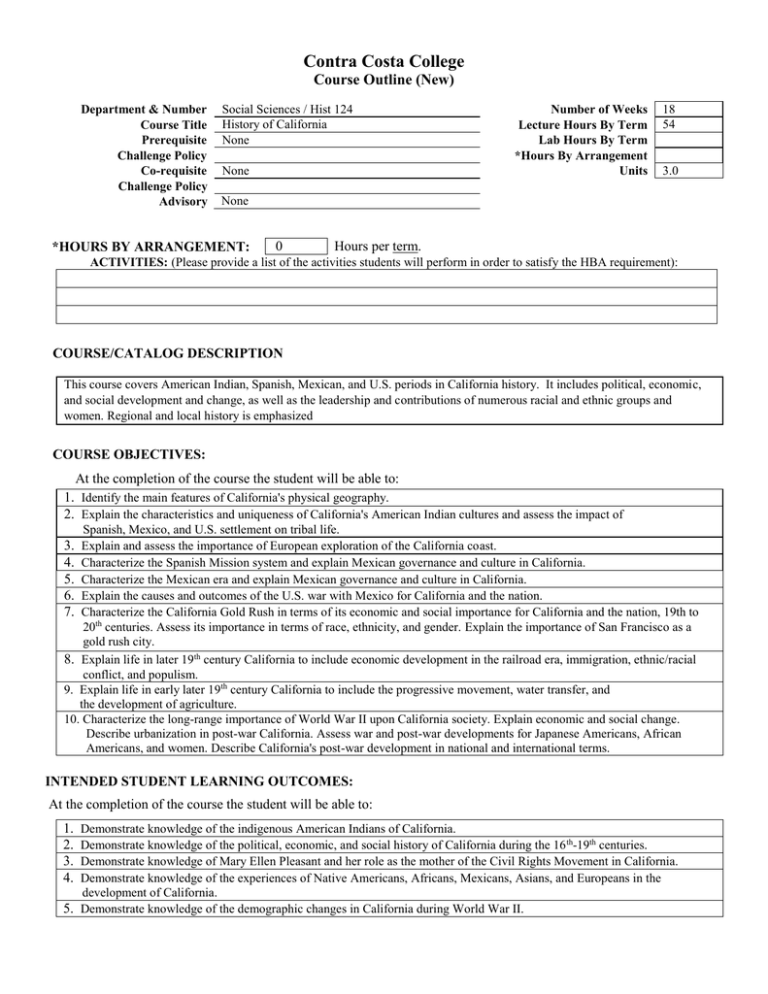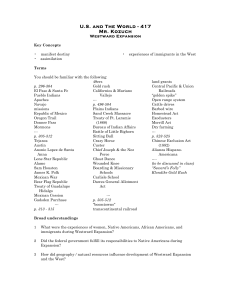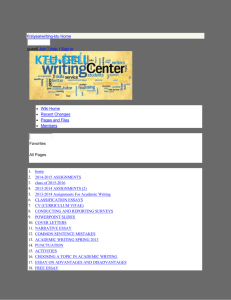HIST 124-S14.doc 89KB Jun 03 2014 02:08:41 PM
advertisement

Contra Costa College Course Outline (New) Department & Number Course Title Prerequisite Challenge Policy Co-requisite Challenge Policy Advisory Social Sciences / Hist 124 History of California None None Number of Weeks Lecture Hours By Term Lab Hours By Term *Hours By Arrangement Units 18 54 3.0 None *HOURS BY ARRANGEMENT: 0 Hours per term. ACTIVITIES: (Please provide a list of the activities students will perform in order to satisfy the HBA requirement): COURSE/CATALOG DESCRIPTION This course covers American Indian, Spanish, Mexican, and U.S. periods in California history. It includes political, economic, and social development and change, as well as the leadership and contributions of numerous racial and ethnic groups and women. Regional and local history is emphasized COURSE OBJECTIVES: At the completion of the course the student will be able to: 1. Identify the main features of California's physical geography. 2. Explain the characteristics and uniqueness of California's American Indian cultures and assess the impact of Spanish, Mexico, and U.S. settlement on tribal life. Explain and assess the importance of European exploration of the California coast. Characterize the Spanish Mission system and explain Mexican governance and culture in California. Characterize the Mexican era and explain Mexican governance and culture in California. Explain the causes and outcomes of the U.S. war with Mexico for California and the nation. Characterize the California Gold Rush in terms of its economic and social importance for California and the nation, 19th to 20th centuries. Assess its importance in terms of race, ethnicity, and gender. Explain the importance of San Francisco as a gold rush city. 8. Explain life in later 19th century California to include economic development in the railroad era, immigration, ethnic/racial conflict, and populism. 9. Explain life in early later 19th century California to include the progressive movement, water transfer, and the development of agriculture. 10. Characterize the long-range importance of World War II upon California society. Explain economic and social change. Describe urbanization in post-war California. Assess war and post-war developments for Japanese Americans, African Americans, and women. Describe California's post-war development in national and international terms. 3. 4. 5. 6. 7. INTENDED STUDENT LEARNING OUTCOMES: At the completion of the course the student will be able to: 1. 2. 3. 4. Demonstrate knowledge of the indigenous American Indians of California. Demonstrate knowledge of the political, economic, and social history of California during the 16 th-19th centuries. Demonstrate knowledge of Mary Ellen Pleasant and her role as the mother of the Civil Rights Movement in California. Demonstrate knowledge of the experiences of Native Americans, Africans, Mexicans, Asians, and Europeans in the development of California. 5. Demonstrate knowledge of the demographic changes in California during World War II. COURSE CONTENT (Lecture): 1. Explain the physical geography of California 2. Discuss the indigenous culture of various American Indian groups in California 3. Identify American Indian archaeological sites throughout California. 4. Identify California museums with significant American Indian collections. 5. Discuss the exploration of Spanish conquistadors and their impact on California and the entire Western hemisphere. 6. Discuss the Spanish, Californios, and American practices and institutions on American Indian life and culture 7. Discuss Spanish settlement and culture with emphasis on the mission system. 8. Discuss the Ranchero or Mexican era. Mexican governance and culture under the Californios. 9. Discuss the U.S. and Mexican War (1846-1848). 10. Analyze the outcome of the U.S. and Mexican War and discuss the U.S. acquisition of California. 11. Discuss California’s admission to the U.S. as a free, and its condoning of slavery. 12. Analyze the 1849 gold rush and its social and economic impact on California, with emphasis on San Francisco. 13. Analyze the ethnic and racial conflict during the gold rush era and throughout the 19th century. 14. Discuss the role of women during the gold rush era. 15. Discuss California immigration in the late 19th and early 20th century. 16. Discuss Angel Island as an immigration station (1910-1940). 17. Analyze the economic growth and social and political change in California in the 20th century. 18. Analyze the Bracero Program (1942-1964) and the growth of labor unions since the 1930s. 19. Discuss the role of World War II (1939-1945) in California’s growth, with emphasis on Richmond, CA. 20. Emphasize the economic growth, ethnic/racial change, and urbanization in California since World War II. 21. Discuss California’s role as a national leader in agricultural production. COURSE CONTENT (Lab): METHODS OF INSTRUCTION: Lecture/Discussion Audio-Visual Cooperative Learning Field Trips INSTRUCTIONAL MATERIALS: NOTE: To be UC/CSU transferable, the text must be dated within the last 7 years OR a statement of justification for a text beyond the last 7 years must be included. Textbook Title: Author: Publisher: Edition/Date: Justification Statement: Textbook Reading Level: The Elusive Eden: A New History of California Richard Rice, et. al McGraw-Hill Book Company 4th edition, 2012 (For textbook beyond 7 years) 13.1 OUTSIDE OF CLASS WEEKLY ASSIGNMENTS: Title 5, section 55002.5 establishes that a range of 48 -54hours of lecture, study, or lab work is required for one unit of credit. For each hour of lecture, students should be required to spend an additional two hours of study outside of class to earn one unit of credit. State mandates that sample assignments must be included on the Course Outline of Record. Outside of Class Weekly Assignments Weekly Reading Assignments (Include detailed assignment below, if applicable) Hours per week 3 Reading #1: Read the section in the textbook on Chumash cosmology and human origin stories; discuss their views on the origins of humanity. Reading #2: Read the section on women during the California gold rush, and discuss the main role of the American women versus the role and occupations of foreign women, according to the author. 3 Weekly Writing Assignments (Include detailed assignment below, if applicable) Writing #1: Write a short essay and describe the controversy around James Benney and his guidebook which provides the GPS coordinates to dozens of American Indian sites in the East Bay. Explain whether you agree or disagree with Benney’s actions. Did he publish his guidebook to help protect and preserve these vulnerable sites, or was his book written simply to make money and a name for himself? Writing #2: Read the section on the Bracero Program (1942-1964). Write a short essay describing the Bracero Program and indicate whether you believe this joint U.S.-Mexican program to bring Mexican migrant farmworkers into California during WWII was effective or not. Weekly Math Problems (Include detailed assignment below, if applicable) Lab or Software Application Assignments (Include detailed assignment below, if applicable) Other Performance Assignments (Include detailed assignment below, if applicable) 0.5 Visit to a local museum collection with American Indian artifacts and record observations in class journal. STUDENT EVALUATION: (Show percentage breakdown for evaluation instruments) Course must require use of critical thinking, college-level concepts & college-level learning skills. For degree credit, course requires essay writing unless that requirement would be inappropriate to the course objectives. If writing is inappropriate, there must be a requirement of problem-solving or skills demonstration. 25 % Essay (If essay is not included in assessment, explain below.) 50 15 10 % % % % % % Computation or Non-computational Problem Solving Skills Skills Demonstration Objective Examinations Other (describe) Homework assignments Journal Report – observations from museum field trip GRADING POLICY: (Choose LG, P/NP, or SC) Pass / No Pass x Letter Grade 90% - 100% = A 80% - 89% = B 70% - 79% = C 60% - 69% = D Below 60% = F 70% and above = Pass Below 70% = No Pass Prepared by: Manu Ampim Date: 5-2-14 Student Choice 90% - 100% = A 80% - 89% = B 70% - 79% = C 60% - 69% = D Below 60% = F or 70% and above = Pass Below 70% = No Pass

![Submission 68 [doc]](http://s3.studylib.net/store/data/008000926_1-fed8eecce2c352250fd5345b7293db49-300x300.png)

